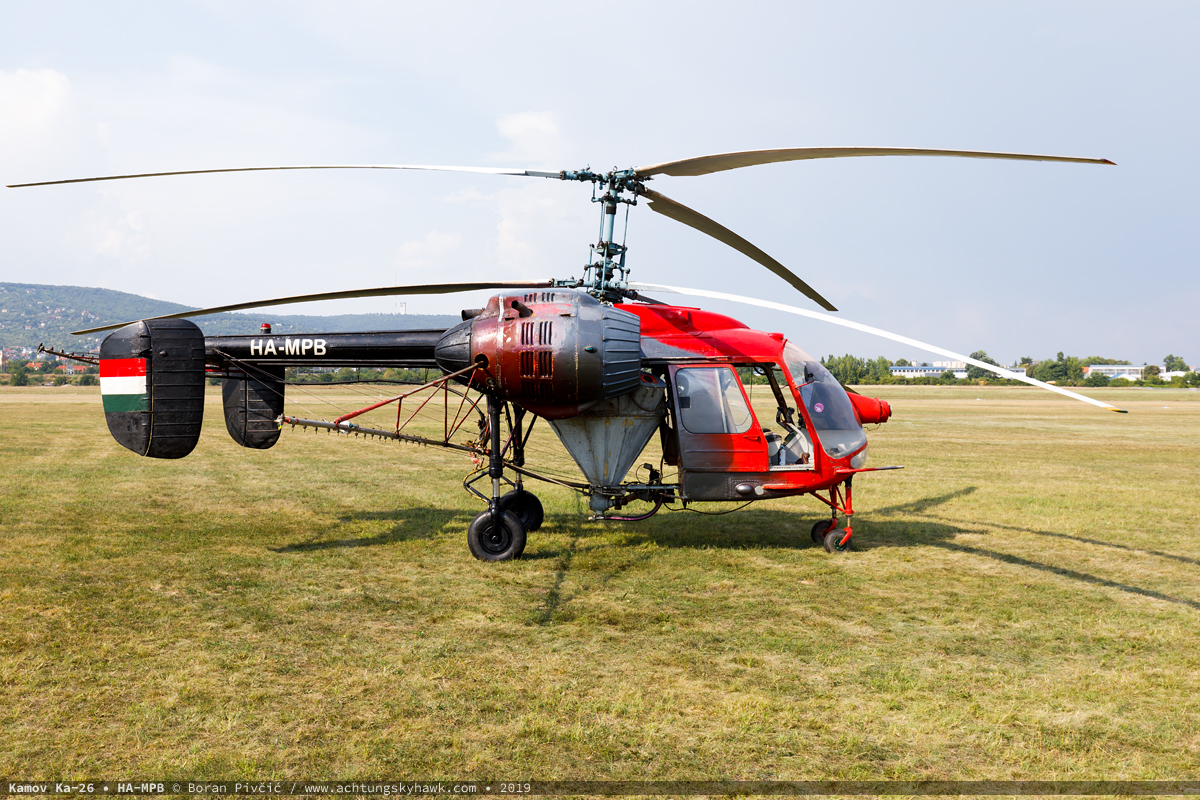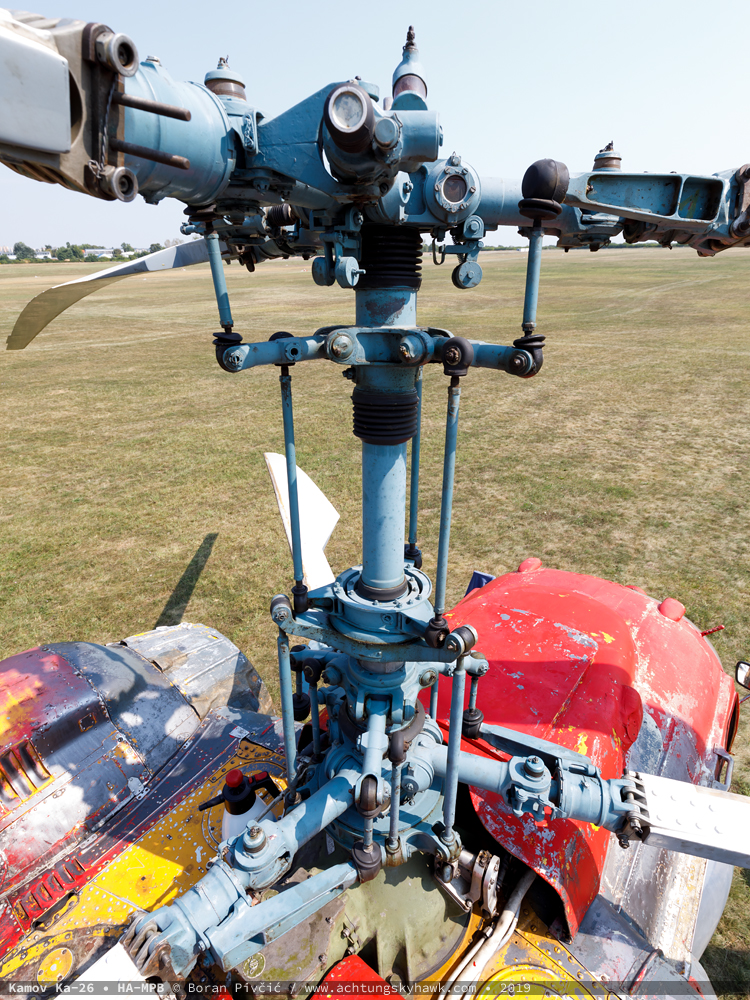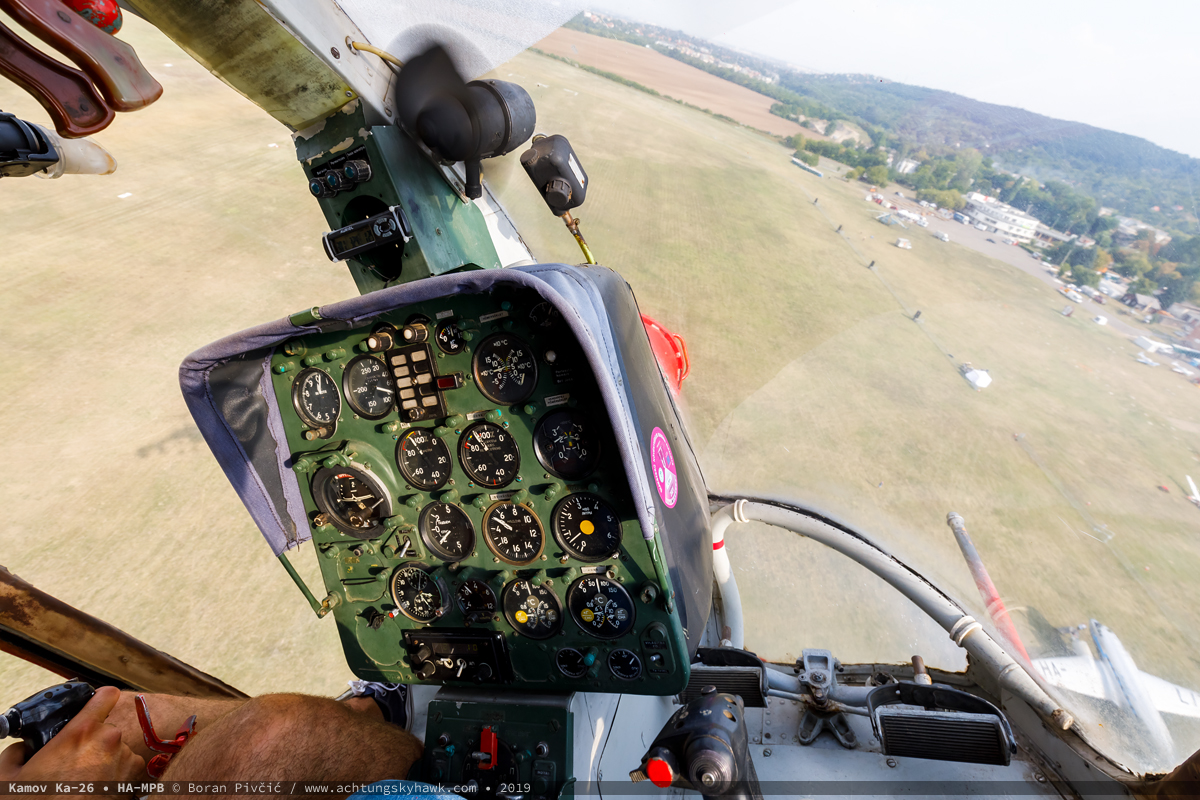By me
All photos me too, copyrighted
Even though I’ve been a fixed wing driver from Day One (private and training helicopters being so rare in Croatia), I’ve nevertheless always maintained a fancy for all things rotary. Indeed, my first ever flight – back when I was just a toddler – had been on a Yugoslav Air Force Mi-8, followed up later in adulthood with hops on the Bell 429 demonstrator, and with Red Bull’s own Rainer Wilke on the fully aerobatic Bo-105 (an experience I’m not likely to forget!). From then on however, my contact with the helicopter world had been reduced to being on the working end of the camera viewfinder – a situation that would dramatically change for the better in the summer of 2019.
Having been aware of my long-standing desire to photograph a piston engine Kamov up close, a friend from neighboring Hungary – himself an avid helicopter spotter – had managed to do me one better, arranging not only a “free hand” photo session… but also a short semi-aerobatic flight. The only string attached was that I get my arse to Budapest on my own accord – a condition I was more than happy to accept! 😀

It may be the textbook definition of the world “fugly” – but on that day it was the most beautiful helo in the world!
The HA Ka
The rather colorful bird that would be my ride for the day goes under the name HA-MPB, and sports the serial 77 061 09 – a typical Soviet sausage that tells you (almost) everything you need to know:
- 77 … manufactured in 1977
- 061 … as part the 61st batch made (out of 65 in total)
- 09 … and the ninth example in the batch
This puts it among the youngest examples of the 848 made in total between 1969 and 1978 – and one of at least 149 that would eventually serve in Hungary (either straight from the factory, or through resales). Unlike the vast majority of its brethren however, MPB is still very much active, and spends most of its uptime dusting crops up and down the country. Indeed, on this day it had popped into Budaörs Airfield (LHBS, not a stranger to me) solely to participate in the upcoming Budaörs Airshow, following which it would quickly depart back into the southern fields and resume normal operations 🙂 .
While my roster at work had prevented me from staying the show’s full three days, I had nevertheless had ample time to pour over MPB in much detail. Though many of the design’s finer nuances will inevitably be lost on me – Fixed Wing Guy, remember* – there is nevertheless still enough eye candy here to arouse the interest of even the most basic aviation enthusiast!
* any corrections from whirlybird drivers would be most welcome!

Getting ready for the day’s practice run with a lick of paint and a thorough wash. Despite the performance penalties of the extra weight, MPB would fly its routine in full crop spraying kit…

In addition to their distinctive main spray bars, many Ka-26s feature a secondary unit slung from the horizontal stabilizer. Specs I found online indicate that with all three in operation, the average 26 could dispense up to 12 liters of fluid per minute (though dispersion system upgrades in 1978 and 1979 would improve on that by a couple of liters/minute)

In the crop dusting configuration, the hopper can accommodate up to 900 kg of fluid. A neat trick is that it’s actually part of a removable payload module that can be easily taken out in the field, and replaced with the minimum of specialized tools by a selection of other factory-made modules (passenger, ambulance, freight platform, sling hook, …)

Not your usual view! Despite its unwieldy look and apparent bulk, from the top it is obvious that the Ka-26 is actually quite compact, sporting the minimum amount of structure necessary to bring together the engines, cabin, rotor system and payload module. There blades themselves are actually composite and very light, and feature substantial leading edge protection at their tips – all of which gives them a solid 5000 hour service life, even in the rough-and-tough going at low altitude

The party piece of (almost) every Kamov design: the counter-rotating coaxial main rotor. Though mechanically more complex than the conventional arrangement, this setup allows for greatly increased efficiency, since the blade area – which produces the lift – is now doubled, and there are no mechanical and friction losses inherent to the tail rotor and its transmission system (which also does wonders during autorotation). Another benefit – epitomized by the Ka-50/52 gunships – is a very high degree of maneuverability in all axes, as well as a much more neutral mass distribution that does wonders for hover characteristics, general handling and overall agility

Arretir! Drawing heavily upon Kamov’s naval experience, the Ka-26 could be equipped with a full IFR panel and some pretty sophisticated kit for its class – stuff that didn’t always sit well with operators, since it tended to add complexity and increased maintenance costs. Many examples (especially those used at very low altitude) would be stripped down in actual operations; MPB however had retained most of its factory setup, minus the blind flying gear

Having spent the majority of its life in Hungary, MPB sports a typically curious mix of Russian and Hungarian dials, which do add a lot of charm to the cockpit…

Being one of the very few (maybe even only) production light helicopter with TWO piston engines, the Ka-26 does sport a lot of powerplant-related switches and knobs – so much so that it seems you need three arms to successfully start it first time out…

More traces of the Ka-26’s Soviet design heritage: the single primer pump in the middle (which is turned into the direction of the desired engine before being actuated), and the air system valve w/ pressure gauge, which provides the juice for the main wheel brakes (a common solution on Soviet aircraft to avoid the weight penalties and poor cold weather performance of conventional hydraulics)

Another icon of Soviet general aviation: the venerable and dependable M-14 nine cylinder radial, here in its V-26 version developing 325 HP. To tackle the unique aspects of helicopter flight – high RPM, high throttle and low (or no) forward airspeed, the fit on the Ka-26 features powerful cooling fans (visible behind the fully opened cowl flaps), which force air over the cylinders to keep them sufficiently cool regardless of flight regime. They also make a LOT of noise!

Two big Soviet radials, two huge coaxial rotors, a traditional cockpit fan – and a semi-aerobatic duet with a 1950s Hiller UH-12… yep, didn’t mind the four hour drive one way!

One a pristine vintage “oldtimer”, the other a no-nonsense everyday working machine… one conventional on Lycoming power, the other coaxial with twin radials… one user-friendly Western, the other utilitarian Eastern… fun is guaranteed! Another interesting feature of the Ka-26 – negated here by the open door – is that the cabin is actually pressurized to slightly above ambient, to prevent spray and chemicals getting in during crop dusting ops
And finally, a bit of video from the inside… admittedly, not the best quality (the lighting was marginal all throughout the day), but hopefully the action will make up for it! Also not the piercing turbine-like noise in both clips; those are the aforementioned cooling fans spinning their heads off 😀 .
Bonus content: Hiller UH-12D • HA-MIG
Drooling all over the Ka-26 is fine and well – but when you get to fly in a duet with a vintage Hiller, you should at least try to make an effort to snap it as well! 😀 Returning back to the apron after our run, I was lucky enough to stumble upon said helicopter and its owner, who kindly allowed me to snoop around and bit and soak up the beauty of one of the world’s earliest mass produced light helicopters…

Halfway through a thorough wash following its practice display. Manufactured in 1959 with the serial 1145, MIG would serve first with the US Army as 58-5496, before going civilian as N67664 and N16MQ. Sold to Hungary in 1997 (as one of a number of UH-12s coming into the country during the 90s), it would eventually end up in the hands of Fly-Coop, one of the largest aircraft operators of the Budapest area. Note the exposed tail rotor transmission atop the tail boom

Though the type normally sports the six cylinder Lycoming VO-435 developing 265 HP, this particular machine had at one point been retrofitted with the more powerful Lycoming VO-540, developing a chunky 305 HP (it showed during the display!). Of note is the engine V prefix, which stands for “vertical” – denoting the modifications for the only possible way of installing it into a light helicopter

A panel that can easily provoke traumas in anyone who had flown a 1960s Cessna – no rhyme or reason in the layout, and made by someone who studied economics, not ergonomics. That notwithstanding, surely a cool place to sit!
Traditionally, I would like to extend my sincerest thanks to all the people – ground and air crews alike – that had made this photo shoot possible, particularly Gergely C.!
Sources:
- Air History – Ka-26 production list (PDF) + serial decode (also PDF)
- Aviainfo.hu – MA-MIG data and history
- Aviastar.org – Ka-26 history
ka 26: how high is the rpm of one piston engine at 100% throttle?
I must admit that I do not know; checked my photo database and I don’t have a panel shot during takeoff…